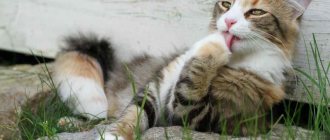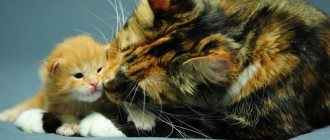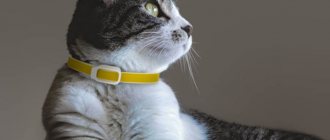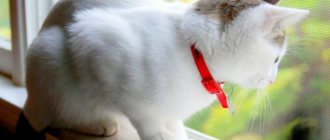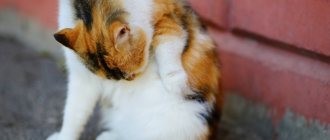Signs of a kitten having fleas
You can assume that a kitten has fleas if you find the baby on the street or if his mother has these insects. Pests cannot appear if the animals do not leave the house and do not come into contact with other cats, undergo preventive treatment and live in good sanitary conditions.
Signs of a kitten having fleas
Outwardly, a kitten may look absolutely healthy, so the presence of insects in its fur can only be determined upon examination. To do this, spread the fur at the withers so that the skin is visible. Signs of flea infestation:
- Black fragments (insect excrement) are visible;
- White specks (parasite eggs) were found;
- There are inflammatory processes on the skin, wounds, bite marks;
- The insects themselves are noticed (fleas have a black or dark brown, oblong body).
You can also suspect an infection based on your pet’s behavior. If he often itches his paw and suddenly starts and stops the process, he may have fleas. This behavior is caused by painful insect bites. In addition, symptoms such as lethargy and poor appetite may be present.
Article on the topic: How to find out if a cat has fleas
How to use drops correctly?
Not every animal lover knows how to properly rid a kitten of fleas. This must be done in such a way as to protect the cat as much as possible from poisoning by the poisons of the drug. To do this, you need to spread the fur on the animal’s withers and apply the product in the required amount. Then, for greater reliability, rub it with your fingers. After treatment, the kitten should not be washed or combed for at least 2 days.
If kittens have fleas in large quantities, then drop the drug along the entire spine, a few drops at a distance of 2-3 cm from each other. This will achieve a better effect. The instructions for each individual drug will indicate the number of drops required to achieve the result.
Drops Bars
If a kitten has fleas, veterinarians know what to do. Such specialists will advise and help you choose the best insect repellent that is individually suitable for each animal. One of these drugs is the flea remedy Bars, which has proven itself as a powerful insecticide. It is a clear, oily liquid with a yellow tint. The release form of the drug Bars is bottles of 1 and 1.4 ml, the kit also includes a convenient dropper pipette.
The active ingredient of the drug is the pyrethroid permethrin. This component is not capable of causing harm to animals or humans, but it has a fatal effect on insects. The effect of the substance is quite long; after treating the animal, for two months, the parasites are destroyed.
Dan's drops
This drug can be used to treat animals older than two months. Dana's product can protect a kitten from many types of insects, as it has a wide spectrum of action. The release form of the drug is pipettes, dosage 0.5 ml. Depending on the weight of the kitten, it is necessary to calculate the number of pipettes. If a kitten has fleas for 2 months and its weight is 1 kilogram, then you need to use one dose of the drug, and if the animal weighs 2 kilograms, then two.
Drops of Stronghold
The active substance of this drug is selamectin. These anti-flea drops for cats are a colorless, clear solution placed in convenient pipettes. Depending on the weight of the animal, the product is available in different dosages.
The drug Stronghold is safe for cats, provided that the instructions are followed and the dosage is accurately selected.
This drug is well absorbed and remains for a long time in the tissues and organs of the animal, which ensures the complete elimination of fleas and their larvae, and also guarantees protection against their appearance for a period of more than one month.
This flea remedy for kittens does not contain oil and has a pleasant smell. Therefore, within 30 minutes after using the drops you can come into contact with the animal.
Drops Frontline
The French drug Frontline has an insecticidal and acaricidal effect. Its main advantage is its absolute safety for the animal. The active ingredient of the product is fipronil, which is able to penetrate only into the sebaceous glands (the upper layer of the epidermis) of the animal. This component of the drug does not enter the kitten’s blood, so it can be used for both treatment and prevention.
Frontline can even be used to treat nursing or pregnant cats. The downside of the drug is that it kills only adult parasites, flea eggs remain unharmed. Therefore, after a month, the procedure should be repeated.
Features of flea removal in kittens
How to remove fleas from a kitten at home depends on the age of the baby and the number of insects. Up to 3-4 months, kittens have a very weak immune system; the use of chemicals can cause more harm to the pet’s health than the presence of parasites. Therefore, sometimes it is worth holding off on removal, especially if there are very few insects on the fur.
Only home methods are suitable for treating newborn kittens under one month of age. From 2-3 months, some chemicals can be used.
If the baby has not yet been weaned from its mother, all substances applied to its fur will enter the digestive system of the cat, and then the kitten during feeding through milk.
The use of insecticidal preparations based on poisons is permissible in kittens only after reaching 6 months of age. They are applied exclusively to the withers - a place that the pet cannot reach when licking the fur.
It is believed that a cat can rid a kitten of fleas while licking, but no matter how much she chases parasites through the baby’s fur, she cannot cope with this scourge without your help.
For the flea removal process to be effective, it is necessary to treat all cats in the house at the same time. It is advisable to carry out a general cleaning and eradicate insects in carpets, upholstered furniture, along baseboards and in pets’ sleeping areas.
Please note that the use of some products is permissible only after a certain period of time after vaccination of the animal. Strong drugs should also not be used if your pet is sick.
Traditional methods
You can get rid of fleas on a kitten at home without the use of special chemicals. This is especially true if the baby is less than 2 months old. Traditional methods are gentle and harmless, but sometimes tedious and not effective enough. But if you have no choice, it's worth trying them. How to remove fleas from a kitten using traditional methods: manually or using natural remedies.
Mechanical removal
By rights, the safest method of getting rid of fleas is mechanical, which allows you to remove insects even from newborn kittens. At the same time, it is the most labor-intensive and time-consuming, since it is not possible to quickly get rid of fleas by combing due to the presence of numerous clutches of eggs.
To carry out the procedure, you will need a hard plastic comb with frequent rounded teeth and a white sheet of paper. Combing fleas should begin from the back, gradually moving to the abdomen and paws. It is not recommended to manipulate the pet's head - you can injure the kitten's ears, nose and eyes. Any fleas on the paper should be immediately crushed or thrown into a container of water. The processing comb also needs to be periodically cleaned of accumulations of insects and hair.
You need to carry out the procedure twice a day until the fleas disappear. One combing session should take about 10 minutes on average. As a rule, it takes 1 month to solve the problem. Afterwards, it is necessary to check the fur for several weeks, since new individuals could emerge from the remaining eggs.
Bathing
Plain water will not get rid of fleas. But if you add salt, tansy or wormwood to the bath, the insects will begin to disappear.
Salt bath. Add table salt to warm water at the rate of 1 tbsp. 200 ml, dissolve. Place your pet in the solution for 10 minutes. Then pat the fur dry with a towel and comb out with a comb. Repeat the procedure every week.
A decoction of wormwood or tansy. Brew the chopped herb in boiling water (1 tablespoon per glass). Prepare a warm bath and pour in the infusion. Keep your pet in the solution for several minutes and dry the fur well. The procedure can be carried out several times a week.
Important! When bathing, be careful not to get water into your pet's ears, nose or eyes!
Tar soap
This flea remedy for kittens is completely safe and quite effective. The soap needs to be turned into thick foam. To make the process easier, you can grate the piece and dissolve it in warm water. The foam should be rubbed into the pet’s fur and rinsed off after a few minutes. To remove dead insects, you can comb the fur after drying.
Special chemicals
If a kitten is older than 2 months and the baby has already been weaned from its mother, some chemicals can be used. Before using them, it is important to assess the kitten’s health; if it is weakened, you should choose the more gentle methods described above, or consult a veterinarian. The first time you need to use the product in a small volume to assess the reaction of your pet’s body.
Shampoos
The most affordable, popular and relatively harmless means for getting rid of fleas at home are shampoos based on plant extracts, such as celandine, or synthetic toxic substances.
Important! The packaging of the shampoo should indicate the age at which it should be used! Make sure this product can be used for your pet.
The kitten must be treated with the drug according to the instructions on the package, then thoroughly rinse off the remaining shampoo with warm water, dry the fur and comb out dead fleas and their eggs. Usually only 2-3 baths are enough to completely remove insects.
Collars
These products are designed to protect the kitten from re-infection with fleas, but they are unlikely to be able to exterminate the insects. Collars can be used from 6-8 months of age.
Features of using flea collars:
- They can rub the delicate skin on the kitten’s neck;
- In some cases they cause allergies and irritation;
- The kitten will try to remove the collar and may damage the integrity of the skin with its claws;
- The baby will experience discomfort from the uncomfortable thing.
Flea remedies for kittens
It is advisable to use collars if there are many pets in the house and some of them have fleas, as well as if a nursing cat is infected. It is worth using them for some time after the insects have hatched in order to prevent re-infection by individuals hatched from laid eggs.
Article on the topic: Flea collar for cats
Traditional methods for getting rid of fleas on a cat
Folk remedies for fleas for cats and kittens have a great advantage over special sprays and drops - when used correctly, they are absolutely harmless to pets and humans. Folk remedies have been used since ancient times to repel parasites and protect yourself and cats.
Traditional recipes are also good for their cost-effectiveness - almost all the components of the product can be purchased at a regular pharmacy at a very modest price. Most often, folk remedies such as wormwood, garlic, and essential oils are used.
Do not forget that cat treatment will be most effective if the entire apartment is cleaned and disinfected from fleas. It is important to treat your cat even if it looks healthy.
Sagebrush
Wormwood is one of the most effective folk remedies in the fight against parasites. It has a strong acaricidal effect and not only repels, but also destroys insects. This folk remedy can be used in any form:
- Dry herb - 50 g of wormwood should be poured with a liter of boiling water and left for half an hour. Strain the solution. The infusion is used when washing cats and treating premises.
- Alcohol infusion - used for cleaning the house and treating upholstered furniture, blankets, beds and cat trays.
- A fresh plant - wormwood tied in the form of bunches will help against fleas in cats, and will also protect poorly accessible areas of the apartment (behind cabinets, under sofas).
You should wash your cat with a decoction of wormwood outside the house, as the parasites will immediately begin to leave the animal and hide in the farthest corners. It is ideal to carry out the procedure outside, however, during the cold season you can close yourself in a pre-treated bathroom behind a tightly closed door. You can completely (except for the head) place the cat in the wormwood infusion, and then bathe it with a mild shampoo.
